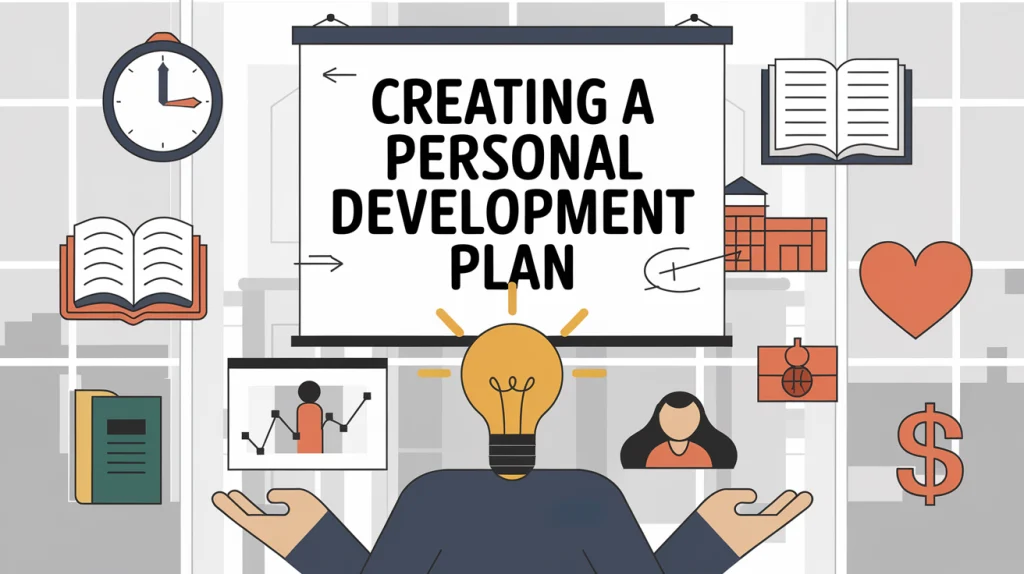A personal development plan can be a powerful tool for anyone looking to improve their skills, advance their career, or achieve personal goals. We will cover the basics of creating an effective personal development plan, provide examples and templates, and offer tips for implementing your plan at work or in school. By understanding and utilizing a personal development plan, you can set clear objectives, measure your progress, and ultimately reach your full potential.

Understanding Personal Development Plans
A personal development plan (PDP) is a structured framework that helps individuals outline their goals, identify areas for improvement, and create actionable steps to achieve their aspirations. A PDP serves as a roadmap for personal and professional growth, providing clarity and direction. The theory behind personal development plans is based on the idea that setting specific, measurable, achievable, relevant, and time-bound (SMART) goals can significantly enhance one’s ability to reach desired outcomes.
Key components of a personal development plan include:
- Self-Assessment: Reflecting on your strengths, weaknesses, opportunities, and threats (SWOT analysis) to understand your current position.
- Goal Setting: Defining clear and concise objectives that you want to achieve.
- Action Plan: Outlining the steps needed to reach each goal, including resources and support required.
- Timeline: Establishing deadlines for each step to ensure consistent progress.
- Monitoring and Review: Regularly reviewing your progress and adjusting the plan as necessary to stay on track.
Key Components of a Personal Development Plan
Setting clear goals is the foundation of any effective personal development plan. These goals should be specific, measurable, achievable, relevant, and time-bound (SMART) to ensure they are both realistic and motivating. For example, if you want to advance in your career, a clear goal might be to achieve a promotion within the next year by enhancing your project management skills. Equally important is identifying your strengths and areas for improvement. Conducting a self-assessment might reveal that you excel in team collaboration but need to develop better leadership skills. This balanced view helps you focus on the right areas for growth.

Once your goals are set and your strengths and weaknesses are identified, the next step is to develop action steps and strategies to achieve your objectives. For instance, if your goal is to improve leadership skills, your action plan might include taking a leadership course, seeking mentorship from a senior manager, and volunteering to lead team projects. Tracking your progress and adjusting your goals is crucial for staying on course. Regularly reviewing your development might show that you’ve made significant strides in team management but need more practice in conflict resolution. Adjusting your plan to include additional training or practice sessions ensures continuous improvement and sustained motivation.
Sample Personal Development Plans
Sample personal development plans can provide valuable insights into how to structure your own plan and set realistic goals. Here are a few examples that illustrate different approaches to personal and professional growth:
| Feature | Career Advancement Plan | Skill Enhancement Plan | Personal Development Plan for Students |
|---|---|---|---|
| Goal | Achieve a promotion to senior management within 18 months | Gain proficiency in digital marketing within 6 months | Improve academic performance and enhance study skills over one semester |
| Strengths | Strong team collaboration, excellent communication skills | Strong analytical skills, basic marketing knowledge | Strong work ethic, good time management |
| Areas for Improvement | Leadership, strategic planning | In-depth knowledge of digital tools and strategies | Note-taking, exam preparation techniques |
| Action Steps | – Enroll in a leadership development course- Seek a mentor- Lead a cross-departmental project | – Take an online course- Run a marketing campaign- Attend webinars and networking events | – Implement active recall and spaced repetition- Join a study group- Attend note-taking workshops |
| Timeline | Complete course in 6 months; lead a project in 9 months | Complete course in 3 months; run a campaign in 4 months | Start techniques immediately; join group in 1 month |
| Progress Tracking | Monthly check-ins with mentor; quarterly performance reviews | Review campaign performance metrics; seek feedback from peers | Monitor grades; seek feedback from professors |
These examples and structured plans illustrate how different goals and contexts can shape a personal development plan. By using these samples as a guide, you can tailor your own plan to fit your unique needs and aspirations.
Personal Development Plan Templates
Personal Development Plan (PDP) Templates are structured tools designed to help individuals set goals, track progress, and achieve personal or professional growth. These templates typically include sections for identifying strengths and weaknesses, setting SMART (Specific, Measurable, Achievable, Relevant, Time-bound) goals, and outlining action steps. Here are three common PDP templates:
- SWOT Analysis Template:
- Strengths: List your key abilities and positive attributes
- Weaknesses: Identify areas for improvement
- Opportunities: Note external factors that could benefit your growth
- Threats: Recognize potential obstacles to your development
- Goal-Oriented Template:
| Goal | Action Steps | Resources Needed | Timeline | Success Measure |
|---|---|---|---|---|
| Improve public speaking skills | 1. Join Toastmasters club 2. Practice speeches weekly 3. Attend communication workshops | – Toastmasters membership fee – Speech preparation materials – Workshop costs | 6 months | Give a 10-minute speech confidently without notes |
| Learn Python programming | 1. Complete online Python course 2. Work on personal coding project 3. Participate in coding challenges | – Computer – Python course subscription – Coding practice websites | 3 months | Build a functional web application using Python |
| Enhance time management | 1. Read “Getting Things Done” by David Allen 2. Implement a digital calendar system 3. Use Pomodoro technique daily | – Time management book – Productivity app subscription – Timer for Pomodoro technique | 2 months | Increase productivity by 25% and reduce missed deadlines by 50% |
3. Skills Development Template:
- Current skill level (1-10)
- Target skill level
- Learning activities
- Practice methods
- Review date
Creating Your Own Personal Development Plan
A Personal Development Plan is your roadmap for growth and improvement. To create one, follow these steps:
- Self-assessment
- Goal definition
- Gap analysis
- Action planning
- Resource identification
- Timeline creation
- Progress tracking
- Adjustment
Start by evaluating your current skills and weaknesses. Then, set clear, achievable goals. Identify the gap between where you are and where you want to be. Plan specific actions to bridge this gap. Figure out what resources you’ll need. Set realistic deadlines for each goal. Regularly check your progress and be ready to adjust your plan as needed.
This process helps you focus on what’s important and take concrete steps towards your goals. It’s a powerful tool for personal and professional development.
Personal Development Plans for Students
Students can greatly benefit from Personal Development Plans to enhance their academic performance and prepare for future careers. A typical student PDP might include:
- Academic goals:
- Improve GPA
- Master specific subjects
- Develop study skills
- Extracurricular activities:
- Join clubs or societies
- Participate in sports
- Volunteer work
- Career preparation:
- Internships or part-time jobs
- Networking events
- Building a professional online presence
- Personal skills:
- Time management
- Public speaking
- Leadership
- Health and well-being:
- Regular exercise routine
- Stress management techniques
- Healthy eating habits
Students should set specific targets for each area, create action plans, and regularly review their progress. This structure helps balance academic pursuits with personal growth, setting a strong foundation for future success.
Implementing Your Personal Development Plan at Work
Implementing a Personal Development Plan in the workplace can significantly boost your career growth and job satisfaction. Here’s how Sarah, a marketing coordinator, put her plan into action:
Sarah identified improving her data analysis skills as a key goal. She approached her manager for support and was allowed to allocate 2 hours per week for online courses. She completed a Google Analytics certification within three months. Sarah then volunteered to lead the team’s monthly performance reports, applying her new skills directly to her work. She also sought mentorship from the company’s senior data analyst, who provided guidance on interpreting complex datasets. After six months, Sarah was able to create data-driven marketing strategies that increased customer engagement by 30%. Her proactive approach not only enhanced her skills but also added value to her team, leading to a promotion to senior marketing analyst within a year.
This real-world example demonstrates how a well-executed Personal Development Plan can align personal growth with organizational goals, leading to tangible benefits for both the employee and the company.


